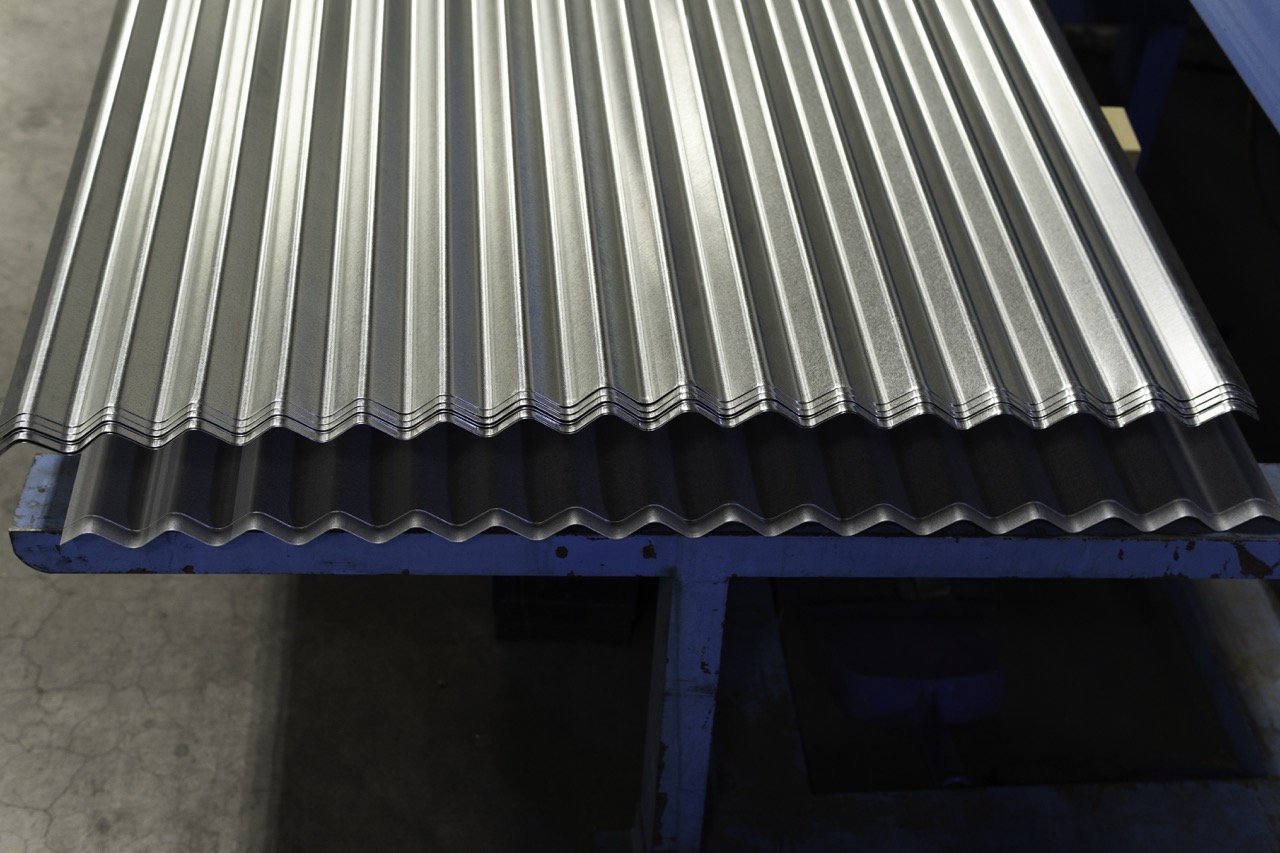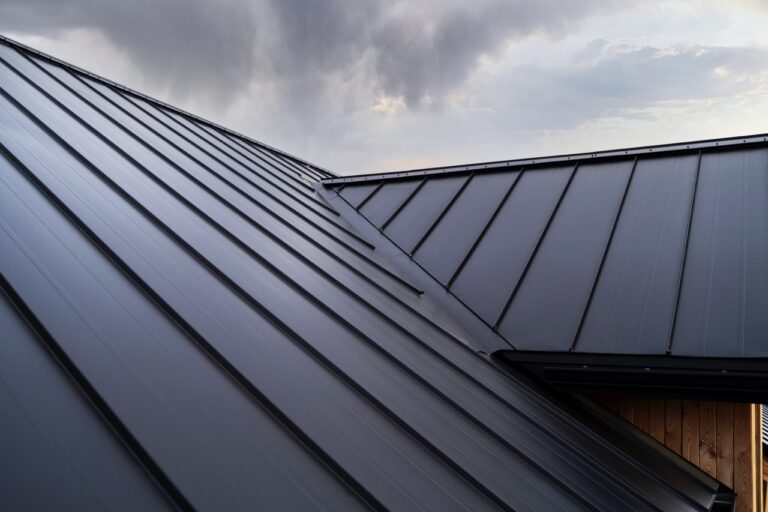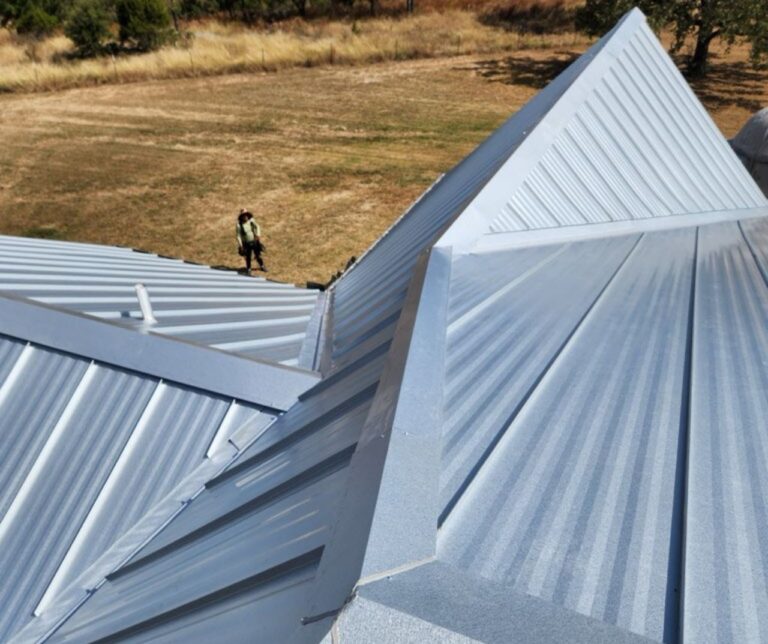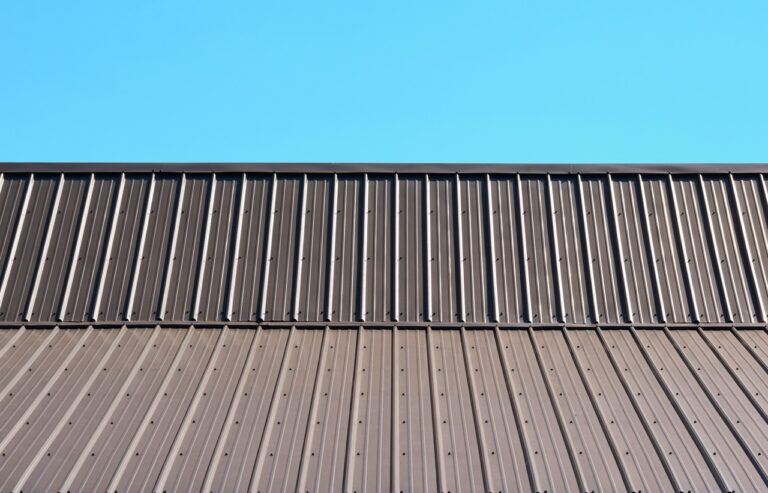Have you ever wondered why some metal roofs last for decades while others develop problems after just a few years? The secret often lies not in the quality of the materials but in how those steel roofing sheets were installed. A proper installation is like building a house on a solid foundation – get it right, and everything else falls into place.
Here in San Antonio, where we face scorching summers, occasional hailstorms, and strong winds, properly installed steel roofing sheets can provide exceptional protection and energy efficiency for your home. But even the highest quality metal roofing materials can fail prematurely if they’re not secured correctly.
In this comprehensive guide, we’ll walk you through everything you need to know about properly installing steel roofing sheets. Whether you’re a DIY enthusiast considering tackling this project yourself or simply want to understand what goes into a quality installation before hiring professionals, this information will help ensure your metal roof performs at its best for decades to come.
Understanding Steel Roofing Sheet Basics
Before diving into installation procedures, it’s important to familiarize yourself with the fundamentals of steel roofing sheets. Steel roofing sheets come in various types, profiles, and finishes, each designed for specific applications and aesthetic preferences.
Types of Steel Roofing Sheets
Corrugated steel panels feature a wavy pattern that provides strength while using less material. These are among the most economical options and are relatively easy to install.
Standing seam metal roofing features vertical legs with a flat area between them. This design creates a sophisticated appearance and offers excellent water-shedding capabilities.
Metal shingles and tiles mimic the look of traditional roofing materials but provide the durability and longevity of steel. These can be more complex to install but offer distinctive aesthetic appeal.
Gauges and Thickness
The thickness of steel roofing sheets is typically measured in gauges, with lower gauge numbers indicating thicker material. For residential applications, 26-29 gauge steel is common, while commercial buildings often use 24 gauge or thicker. Thicker gauges provide better durability but come at a higher cost and can be more challenging to cut and manipulate.
Protective Coatings
Most steel roofing sheets feature protective coatings to prevent corrosion and extend their lifespan. Galvanized steel has a zinc coating, while Galvalume® combines zinc and aluminum for enhanced protection. Many sheets also include a painted finish with specialized coatings like Kynar 500® or Hylar 5000® that resist fading and chalking.
Understanding these basics helps you select the right steel roofing sheets for your specific needs and ensures you have the appropriate tools and techniques for installation.
Tools and Materials You’ll Need
Proper installation of steel roofing sheets requires specific tools and materials. Having everything ready before you begin will save time and frustration.
Essential Tools
- Cordless drill with clutch settings – Perhaps your most important tool, used for driving fasteners without overtightening
- Metal cutting tools – Tin snips for small cuts, electric metal shears or nibbler for longer cuts
- Tape measure and chalk line – For accurate measurements and marking
- Roofing hammer – Features a gauge for setting proper nail depth
- Safety equipment – Including gloves, safety glasses, and fall protection
- Ladder or scaffolding – For safe roof access
- Magnetic sweeper – To collect metal shavings after cutting
Required Materials
- Steel roofing sheets – Selected based on your specific project requirements
- Underlayment – Typically synthetic materials designed for metal roofing
- Fasteners – Self-drilling screws with neoprene washers, matched to your panel type
- Closure strips – Foam pieces shaped to match panel profiles
- Sealant – Butyl tape and/or polyurethane caulk designed for metal roofing
- Flashing – For transitions, valleys, and penetrations
- Ridge caps and other trim pieces – For finishing edges and transitions
Optional but Helpful
- Roofing brackets – Creates a platform for working on steeper slopes
- Panel crimper – For standing seam profiles
- Seamer – For mechanically seaming standing seam panels
Remember, quality tools make for quality installation. If you’re doing this as a DIY project, consider renting specialized tools rather than purchasing them for a one-time use.
Safety Considerations for Steel Roof Installation
Installing steel roofing sheets involves significant safety hazards, including falls, cuts from sharp metal edges, and tool-related injuries. Taking proper precautions is essential before you begin.
Fall Protection
Working at height is the most significant danger in roof work. For residential projects:
- Use properly secured ladders with extended rails for roof access
- Install roof jacks and planks to create stable work platforms
- Consider using a personal fall arrest system for steeper roofs
- Never work on wet or icy roofs
Handling Metal Safely
Steel roofing sheets have extremely sharp edges that can cause severe cuts.
- Always wear heavy-duty gloves when handling metal panels
- Carry sheets vertically rather than horizontally to reduce wind resistance
- For longer panels, have multiple people help with lifting and positioning
- Be aware of your surroundings, especially in windy conditions
Weather Considerations
- Never install metal roofing during thunderstorms due to lightning risk
- Avoid installation on extremely hot days, as metal can become too hot to touch
- Be cautious of morning dew, which can make metal slippery
Electrical Safety
- Be aware of overhead power lines when moving metal sheets
- Use properly grounded tools
- Inspect all electrical tools before use
Personal Protective Equipment
At minimum, wear:
- Cut-resistant gloves
- Safety glasses or face shield
- Hard hat
- Non-slip footwear
- Long sleeves and pants
Remember, no roofing project is worth risking your safety. If you’re uncomfortable with heights or lack experience with metal work, hiring professionals is always the safest option.
Preparing Your Roof for Steel Roofing Sheets
Proper preparation creates the foundation for a successful steel roof installation. This phase is crucial and should never be rushed.
Roof Deck Inspection
Begin by thoroughly inspecting your existing roof deck:
- Check for damaged or rotted wood that needs replacement
- Ensure the deck is solid, flat, and free from protrusions
- Verify that the structure can support the weight of steel roofing
- Look for signs of moisture damage or previous leaks
Remove or Cover Existing Roofing
You have two options with existing roofing materials:
Complete removal: This allows full inspection of the deck and creates the best foundation but involves more labor and disposal costs.
Overlay installation: Installing over existing shingles can save time but requires special considerations:
- Confirm local building codes allow overlays
- Ensure the structure can handle the additional weight
- Address any uneven surfaces
Install Underlayment
Underlayment provides a secondary water barrier and helps prevent condensation issues.
- Use synthetic underlayment specifically designed for metal roofing
- Install in overlapping rows, starting from the bottom edge
- Secure according to manufacturer specifications
- Pay special attention to valleys and roof penetrations
Install Purlins (If Applicable)
For some installations, especially over existing shingles, installing purlins (horizontal framing members) creates an air gap and provides a secure fastening surface.
- Space purlins according to panel type and local wind load requirements
- Ensure purlins are level and properly secured to rafters
- Use treated lumber or metal purlins for longevity
Flashing Preparation
Prepare all areas requiring flashing:
- Chimneys
- Vent pipes
- Skylights
- Valleys
- Wall intersections
Proper preparation might seem time-consuming, but it’s far easier to address issues now than after your steel roofing sheets are installed. Remember, the quality of your preparation directly impacts the performance and longevity of your metal roof.
Measuring and Cutting Steel Roofing Sheets
Accurate measurements and proper cutting techniques are essential for a professional-looking installation and optimal performance of your steel roofing sheets.
Taking Accurate Measurements
- Measure your roof thoroughly, accounting for overhangs, hips, valleys, and penetrations
- Add extra length for overhang at the eaves (typically 1-2 inches)
- Consider panel overlap requirements when calculating coverage width
- Create a detailed roof diagram with all measurements
- Double-check all numbers before ordering materials
Planning Panel Layout
Strategic panel layout minimizes waste and improves appearance:
- Start from the gable end that’s most visible from the ground
- Ensure the last panel at the opposite end will be a reasonable width
- Plan for symmetrical appearance when possible
- Consider how valleys and hips will affect panel layout
Cutting Techniques for Steel Roofing
Hand cutting with snips:
- Ideal for small cuts and detail work
- Use straight-cut snips for straight lines, left or right-cut snips for curves
- Support the panel fully to prevent bending during cutting
Power tools for longer cuts:
- Electric metal shears provide clean cuts with minimal distortion
- Nibblers work well for curved cuts
- Circular saws with metal-cutting blades can be used but create more heat and metal shavings
Important Cutting Tips
- Always wear gloves and eye protection
- Mark cut lines clearly with a chalk line or marker
- Cut panels face-down when using power tools to minimize damage to painted surfaces
- Support panels fully during cutting to prevent bending
- Remove metal shavings immediately to prevent rust staining
- Never use abrasive tools like angle grinders, as they damage protective coatings
Handling Cut Panels
- File or sand any sharp edges after cutting
- Apply touch-up paint to cut edges to prevent corrosion
- Handle cut panels carefully to avoid bending or damaging them
Remember that precise measurements and clean cuts not only improve the roof’s appearance but also enhance its water-shedding capability and overall durability. Taking your time during this phase will pay dividends throughout the life of your steel roof.
Proper Fastening Techniques for Steel Roofing
The way you fasten your steel roofing sheets is perhaps the single most critical factor determining how well your roof performs over time. Incorrect fastening is the leading cause of metal roof failures.
Choosing the Right Fasteners
Self-drilling screws with integrated washers are the standard for most steel roofing applications.
Key considerations for fastener selection:
- Material compatibility – Use fasteners designed for steel roofing to prevent galvanic corrosion
- Length – Must penetrate substrate by at least 3/4 inch
- Washer quality – EPDM rubber washers provide the best seal
- Head type – Choose colors that match your roofing for aesthetic purposes
Fastening Patterns
Different panel profiles require specific fastening patterns:
Corrugated and R-panel fastening:
- Fasten in the valleys, never on the ridges
- Follow manufacturer’s recommended spacing pattern
- Typically requires fasteners every 24″ along the length and at each purlin or framing member
Standing seam fastening:
- Uses concealed clip systems rather than direct penetration
- Clips attached to substrate, then panels attach to clips
- Follow manufacturer’s specifications precisely
Proper Driving Technique
The way you drive fasteners is crucial:
- Use a variable speed drill with clutch settings
- Drive fasteners perpendicular to the panel surface
- Apply consistent pressure without overdriving
- Tighten until the washer is compressed but not deformed
- The washer should create a slight dimple in the metal without warping the panel
Common Fastening Mistakes
Avoid these critical errors:
- Overdriving – Crushes the washer and creates leak points
- Underdriving – Fails to create a proper seal
- Angular driving – Creates an oval-shaped hole that may leak
- Using too few fasteners – Leads to wind uplift issues
- Using incompatible fasteners – Causes premature corrosion
Remember that each panel type has specific fastening requirements. Always consult the manufacturer’s installation guide for your particular steel roofing sheets to ensure you’re using the correct fastening system and pattern.
Sealing and Waterproofing Your Metal Roof
While steel roofing sheets are inherently water-resistant, proper sealing is essential for a completely waterproof roof system, especially at joints, penetrations, and transitions.
Sealant Types for Metal Roofing
Several sealant types are commonly used with steel roofing:
- Butyl tape – Flexible, sticky tape used between overlapping panels
- Polyurethane sealants – Provide excellent adhesion and flexibility
- Silicone sealants – Ideal for high-temperature applications like chimneys
- Closure strips – Pre-formed foam pieces that match panel profiles
Critical Areas Requiring Sealant
Pay special attention to these areas:
- Panel overlaps – Both horizontal and vertical
- Ridge caps – Where roof planes meet at the top
- Eaves and gable ends – Where panels terminate
- Around penetrations – Pipes, vents, skylights
- Valley flashings – Where roof planes intersect
- Transition flashings – Where roof meets wall or changes pitch
Application Techniques
Proper application is essential for effective sealing:
- Clean surfaces thoroughly before applying any sealant
- Apply sealants in continuous beads without gaps
- Position butyl tape properly between panels before fastening
- Use closure strips at ridges and eaves to prevent water and pest infiltration
- Follow manufacturer temperature guidelines for sealant application
Common Waterproofing Mistakes
Avoid these typical errors:
- Using too little sealant
- Applying sealant to wet or dirty surfaces
- Using incompatible sealants that can react with coatings
- Relying on sealant alone where proper flashing is needed
- Neglecting to seal screw heads in certain applications
Remember, water always finds the path of least resistance. A properly sealed steel roof system should provide decades of leak-free performance, but even small oversights in the sealing process can lead to costly water damage.
Installing Steel Roofing on Different Roof Pitches
The pitch (slope) of your roof significantly impacts both the installation process and the type of steel roofing sheets that will perform best. Different pitches present unique challenges and requirements.
Low-Slope Roofs (2:12 to 3:12 pitch)
Low-slope applications require special considerations:
- Use panels designed for low slopes – Standing seam is often preferred
- Increase panel overlaps – Follow manufacturer recommendations for minimum pitch
- Apply sealant at all overlaps
- Consider double underlayment for additional protection
- Be extra careful with fastener placement and sealing
Standard-Pitch Roofs (4:12 to 9:12)
Most residential roofs fall in this range:
- Most steel roofing sheet profiles perform well in this range
- Standard overlap specifications usually apply
- Panels are easier to align and install at these pitches
- Typical fastening patterns can be followed
Steep Roofs (10:12 and greater)
Steep roofs present safety and installation challenges:
- Roof jacks and scaffolding are essential for worker safety
- Panels may slide during positioning – temporary clamps can help
- Working from the bottom up becomes even more important
- Consider shorter panel lengths for easier handling
Installation Sequence for All Pitches
Regardless of pitch, follow this general sequence:
- Install eave trim and starter course
- Work from eave to ridge
- Complete one section before moving laterally
- Install valley flashing before adjacent panels
- Apply ridge caps last
Special Considerations for Complex Roofs
Roofs with multiple pitches require careful planning:
- Transition flashings where pitches change
- Water diversion details at pitch changes
- Specialized ridge details where different pitches meet
The roof pitch affects nearly every aspect of steel roof installation, from panel selection to fastening methods. Always verify that your chosen steel roofing sheets are rated for your specific roof pitch, and adjust your installation techniques accordingly.
Dealing with Roof Penetrations and Flashing
Roof penetrations are potential weak points in any roofing system. Proper flashing and sealing around these areas is crucial when installing steel roofing sheets.
Types of Roof Penetrations
Common penetrations include:
- Plumbing vents and stacks
- Chimneys and flues
- Skylights
- HVAC ducts and vents
- Satellite dish mounts
- Solar panel attachments
Flashing Options for Metal Roofing
Several flashing types are used with steel roofing:
- Pipe boots – Flexible flashings that fit over pipes with adjustable bases
- Custom fabricated flashings – Created for unique penetrations
- Valley flashings – W-shaped channels for water runoff where roof planes meet
- Step flashing – Used where roofs meet vertical walls
- Counter flashing – Overlaps base flashing to provide additional protection
Installation Techniques
Proper installation varies by penetration type, but general principles include:
- Install penetration flashings before surrounding panels when possible
- Cut holes in panels slightly larger than needed to allow for thermal movement
- Use appropriate sealants between flashing and panels
- Follow a “watershed” approach – upper flashings should overlap lower ones
- Secure flashings with compatible fasteners
Chimney and Large Penetration Details
Larger penetrations like chimneys require special attention:
- Install proper cricket (water diverter) on upslope side
- Use step flashing along vertical surfaces
- Apply counter flashing into masonry joints
- Ensure adequate clearance between combustible materials and chimneys
Common Flashing Mistakes
Avoid these typical errors:
- Relying on sealant alone without proper flashing
- Improper overlapping that allows water to flow under flashing
- Using incompatible metals that cause galvanic corrosion
- Fastening through the center of valleys
- Inadequate clearance around hot penetrations like chimneys
Remember that flashing details often determine whether your steel roof will leak. Taking extra time with these critical areas will pay dividends throughout the life of your roof.
Edge Treatments and Finishing Touches
Proper edge treatments not only enhance the appearance of your steel roofing but also provide essential protection against wind uplift and water infiltration.
Eave Details
The lower edge of your roof requires specific treatments:
- Install drip edge or eave flashing to direct water into gutters
- Use foam closure strips to seal the gap between panels and trim
- Ensure proper panel overhang (typically 1-2 inches)
- Apply sealant where necessary for complete waterproofing
- Consider snow retention systems in applicable climates
Gable and Rake Edge Treatments
Side edges require specific finishing:
- Install rake trim over panel edges for a clean appearance
- Secure panels at rake edges with appropriate fasteners
- Use foam closures to seal gaps
- Ensure trim overlap follows watershed principle
Ridge and Hip Caps
These critical areas where roof planes meet require special attention:
- Install vented or solid ridge caps according to ventilation needs
- Use closure strips underneath to prevent water infiltration
- Fasten caps securely while allowing for thermal movement
- Apply sealant as recommended by manufacturer
Fascia and Soffit Integration
Properly integrating roof edges with fascia and soffit systems:
- Ensure proper flashing between roofing and fascia
- Maintain adequate ventilation through soffit systems
- Coordinate fascia colors with roofing for aesthetic appeal
Final Aesthetic Touches
Complete the professional appearance:
- Apply touch-up paint to any scratches or cut edges
- Ensure consistent reveal lines along trim pieces
- Remove any adhesive labels or protective films
- Clean the roof of any debris, fasteners, or metal shavings
These finishing details not only enhance curb appeal but also significantly impact the performance of your steel roofing sheets. A properly finished edge system protects against wind uplift and prevents water from infiltrating underneath your roofing panels.
Post-Installation Inspection and Quality Checks
After completing your steel roofing installation, a thorough inspection helps identify and address any issues before they cause problems. This step is crucial whether you’ve installed the roof yourself or hired contractors.
Visual Inspection
Conduct a comprehensive visual review:
- Check for proper panel alignment and straightness
- Verify that all trim pieces are secure and aligned
- Look for any scratches or damage to panel surfaces
- Ensure all protective films have been removed
- Verify that all valleys, ridges, and transitions appear properly finished
Fastener Inspection
Examine fastener installation throughout the roof:
- Confirm all fasteners are properly driven – neither too tight nor too loose
- Verify that washers are slightly compressed without being crushed
- Check for consistent fastener spacing and alignment
- Ensure all required fasteners are in place according to specifications
- Look for any missed or improperly placed fasteners
Water-Tightness Checks
Assess potential leak points:
- Examine all flashing details around penetrations
- Check seals at ridge caps and other transitions
- Inspect panel overlaps for proper seating and sealing
- Verify that all end laps are properly sealed
- Ensure valley flashing is properly installed and sealed
Debris Removal
Complete the cleanup process:
- Use a magnetic sweeper to collect all metal shavings and loose fasteners
- Remove any excess sealant or caulking
- Clear gutters of any installation debris
- Ensure all tools and materials are removed from the roof
Documentation
Finalize the project with proper documentation:
- Take photos of the completed roof from multiple angles
- Record specific products and materials used
- Document any special installation details
- Retain all warranty information and manufacturer instructions
Remember that finding and addressing small issues immediately after installation is much easier than dealing with problems that develop later. A systematic post-installation inspection is your final quality control step for ensuring a long-lasting, problem-free steel roof.
Maintenance Tips for Long-Lasting Steel Roofing
While steel roofing sheets require significantly less maintenance than many other roofing materials, some periodic care will maximize performance and extend lifespan even further.
Regular Inspection Schedule
Establish a consistent inspection routine:
- Conduct visual inspections twice yearly – typically in spring and fall
- Additional inspections after major storms or extreme weather events
- Check for any loose fasteners or trim pieces
- Examine sealants for signs of deterioration
- Look for any signs of damage or corrosion
Cleaning Procedures
Keep your steel roof clean for optimal performance:
- Remove debris from valleys, gutters, and low spots
- Wash the roof surface periodically to remove dirt and contaminants
- Use gentle cleaning methods – soft brush or low-pressure washing
- Avoid harsh chemicals that might damage protective coatings
- Address any mold or mildew with appropriate treatments
Preventative Maintenance
Take proactive steps to prevent issues:
- Trim overhanging branches that could scratch or damage roofing
- Address any minor issues before they become major problems
- Re-seal any areas where sealant has deteriorated
- Tighten any loose fasteners (but avoid overtightening)
- Apply touch-up paint to any scratches or exposed edges
When to Call Professionals
Some situations warrant professional attention:
- Signs of water infiltration or leaks
- Significant panel damage from fallen objects or extreme weather
- Any structural concerns with the roof deck or supporting structure
- Complex repairs involving multiple components
- When manufacturer warranties require professional service
With proper maintenance, your steel roofing sheets can easily last 50+ years. This minimal maintenance requirement is one of the major benefits of choosing steel roofing over traditional materials, which often need more frequent repair or replacement.
Common Installation Mistakes and How to Avoid Them
Even experienced installers can make errors when working with steel roofing sheets. Being aware of these common mistakes can help you avoid them in your own installation.
Fastener-Related Mistakes
Fastening errors are among the most common issues:
- Overdriving fasteners – crushing washers and creating leak points
- Using incorrect fasteners – leading to corrosion or inadequate holding power
- Improper fastener placement – missing structural supports or fastening at wrong points on panels
- Inadequate fastener quantity – particularly in high-wind areas
- Using mismatched metals – causing galvanic corrosion
Panel Alignment Problems
Proper alignment is crucial for both appearance and function:
- Starting crooked at the eave – causing compound alignment issues
- Failing to check squareness periodically – leading to misaligned panels
- Improper panel overlaps – causing leaks or poor appearance
- Inadequate allowance for thermal movement – resulting in oil-canning or buckling
- Incorrect cutting around penetrations – leading to water infiltration
Flashing and Sealing Errors
Waterproofing details frequently cause problems:
- Improper flashing installation – particularly around complex penetrations
- Inadequate or missing sealant – at critical junctions and overlaps
- Relying too heavily on sealant – where proper flashing should be used
- Using incompatible sealants – that may degrade prematurely
- Failing to follow watershed principles – allowing water to flow under rather than over transitions
Structural Considerations
Underlying issues can compromise your roof:
- Installing over inadequate or damaged decking – causing structural problems
- Failing to account for proper ventilation – leading to condensation issues
- Not verifying load capacity – potentially exceeding structural limits
- Improper handling of panels – causing damage before installation
- Inadequate underlayment – compromising secondary water barrier
How to Avoid These Mistakes
Preventative approaches to ensure quality installation:
- Follow manufacturer guidelines precisely
- Use proper tools designed for metal roofing
- Take time for accurate measurements and layout
- Address any substrate issues before installation
- When in doubt, consult with professionals
Remember that most metal roof failures are not due to material defects but rather to installation errors. Taking your time, following specifications, and being attentive to details will help ensure your steel roofing installation performs as expected.
When to Call Professional Roofing Contractors
While many homeowners consider DIY installation of steel roofing sheets, there are situations where professional installation is strongly recommended.
Complex Roof Configurations
Some roof designs demand professional expertise:
- Roofs with multiple valleys and complex geometries
- Steep slopes requiring specialized safety equipment
- Custom architectural details requiring fabricated pieces
- Historic renovations with special requirements
- Roofs with numerous penetrations and obstacles
Technical Considerations
Certain technical aspects may exceed DIY capabilities:
- Standing seam systems requiring specialized seaming tools
- Projects requiring custom-fabricated flashing
- Structural modifications to support metal roofing
- Complex ventilation requirements
- Situations requiring extensive tear-off of existing materials
Safety Concerns
Safety should always be the primary consideration:
- Steep or high roofs beyond your comfort level
- Lack of proper safety equipment for roof work
- Physical limitations that might compromise safety
- Roofs with challenging access points
- Weather conditions that make DIY work hazardous
Warranty Considerations
Professional installation may be necessary for full protection:
- Manufacturer warranties that require certified installers
- Extended warranty options only available with professional installation
- Insurance requirements specifying professional installation
- Local code compliance requiring licensed contractors
- Financing or rebate programs requiring qualified installers
Finding Qualified Metal Roofing Contractors
When selecting a professional, look for:
- Specific experience with steel roofing sheets
- Proper licensing and insurance
- Manufacturer certifications
- Portfolio of similar projects
- Strong references and reviews
Remember that while professional installation costs more initially, it often proves more economical over time through proper installation, warranty protection, and peace of mind. For many homeowners, the ideal approach is finding the right balance – perhaps handling simpler aspects themselves while bringing in professionals for critical or complex elements.
Conclusion
Properly installed steel roofing sheets provide one of the most durable, energy-efficient, and aesthetically pleasing roofing options available. While the installation process requires attention to detail and specific techniques, the results are well worth the effort.
The key elements we’ve covered – from proper preparation and fastening to flashing details and finishing touches – all work together to create a roofing system that can protect your home for 50+ years with minimal maintenance. By avoiding common installation mistakes and understanding when professional help is warranted, you can ensure your metal roof provides the maximum value for your investment.
Whether you’re installing your steel roof yourself or hiring professionals, this guide provides the knowledge to ensure quality work and optimal results. Remember that even small details matter in metal roofing installation – a properly driven fastener or correctly installed flashing can make the difference between decades of trouble-free performance and premature failures.
For San Antonio homeowners, a properly installed steel roof is particularly valuable given our climate extremes – providing energy efficiency during hot summers, durability during storms, and long-term value that few other roofing materials can match.
FAQs
Can I install steel roofing sheets over my existing asphalt shingles?
How long will a properly installed steel roof last in San Antonio’s climate?
What kind of underlayment should I use with steel roofing sheets?
How do I prevent oil-canning in my steel roofing panels?
Will walking on my steel roof damage it?
How do I choose the right color for my steel roof in San Antonio?
Do steel roofing sheets make more noise during rain than other roofing materials?
How energy efficient are steel roofing sheets in hot climates like San Antonio?
What maintenance does a steel roof require?
How do steel roofing sheets hold up during hailstorms?
——————-
With more than 50 years of experience in manufacturing and metal roof installation, Fasteel – Metal Roof Solutions designs, manufactures, and distributes metal roofing products, including coils, flat sheets, panels, trims, and accessories. Our services include breaking metal, on-site manufacturing, small batch production, and plans and blueprint interpretation to ensure the most accurate estimate. With manufacturing facilities and warehouses in San Antonio and Houston, we cover the entire Dallas, Austin, San Antonio, and Houston metroplex area. In addition, we have a fleet of high-tech roll formers that allows us to expand our coverage to anywhere in the continental United States of America.







